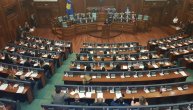On this day, Serbian shrines burned in Kosovo: 16 years since the March pogrom
After the 2004 pogrom, Albanians started accelerating their work to transfer the authority of provisional institutions to Kosovo, negotiations on Kosovo's final status began, followed by the unilateral declaration of independence in 2008
On this day 16 years ago, the March pogrom carried out against Serbs in Kosovo, their property and shrines took place, when 19 people were killed, about 1,000 injured, more than 4,000 Serbs expelled from their homes and 35 Orthodox Christian religious buildings set on fire.
Among those killed were eight Serbs, while 11 Albanians died in clashes with members of international security forces.
How did it all begin?
On March 15, 2004 in Caglavica, a village near Pristina, a young Serb man, Jovica Ivic, 18, was wounded and was taken to the hospital in northern Mitrovica in a serious condition. Protests took place involving residents of this village and other Serb villages in the area (Gracanica, Susica, Laplje Selo, Preoce ...) A day later, three Albanian boys (8, 11 and 12 years old) died when threy drowned in the Ibar River, for which the local media blamed Serbs.
An investigation by UNMIK (United Nations mission in Kosovo) police found these allegations to be false.
All the same, Albanians claimed otherwise, saying that six boys had been running away from people from the Serb village of Zupce, when they fell into the Ibar on March 16, 2004, three of them drowning.
Albanian officials blamed the Serb side for this, sparking anger among Kosovo Albanians.
March 2004 pogrom in Kosovo
Albanians started gathering in the southern part of Kosovska Mitrovica a few hours later, blocking access to the city and crossing a barricade on the Ibar bridge. They began throwing Molotov cocktails and setting UNMIK vehicles on fire. Riots soon spread to 33 locations in Kosovo, involving about 60,000 Albanians, according to an UNMIK report.
At the same time thousands of people protested in cities in Serbia because of these attacks on Serb enclaves. On the evening of the same day that violence erupted in Kosovo, mosques were set on fire in Belgrade and Nis, while the Islamic Community HQ was demolished in Novi Sad.
"If there had not been for the irresponsible and sensationalist coverage of the events of March 17 and 18, things in Kosovo could have gone quite differently," said a report by the OSCE Pristina Office for Media Freedom, published two months after the March violence.
UNMIK's report on the outcome of March unrest
According to an official UNMIK report released by the UN in April 2004, 19 people were killed in the March riots, while several remained unidentified. A total of 954 people were injured, including 61 KFOR soldiers and 65 UNMIK police officers. More than 4,000 Serbs were expelled.
In the two days of Albanian violence, about 800 Serb houses were destroyed and 35 religious buildings were burned down, including 18 monuments of culture, such as the Church of Our Lady of Ljevis in Prizren.
According to the Serbian Orthodox Church's Diocese of Raska-Prizren, in April 2004, the total number of destroyed church facilities was close to 100.
The March pogrom was an introduction into the unilateral declaration of independence
After the 2004 pogrom, Albanians started accelerating their work to transfer the authority of the provisional institutions to Kosovo and Metohija, negotiations on Kosovo's final status began, followed by the unilateral declaration of independence in 2008.
The ethnic cleansing of Serbs in Kosovo and Metohija was done as they are a major obstacle to independence and pan-Albanian unification. Some of the displaced Serbs, whose houses and apartments were destroyed received accommodation in makeshift collective centers or elsewhere in Kosovo and Metohija, while a large number left.
(Telegraf.rs)

